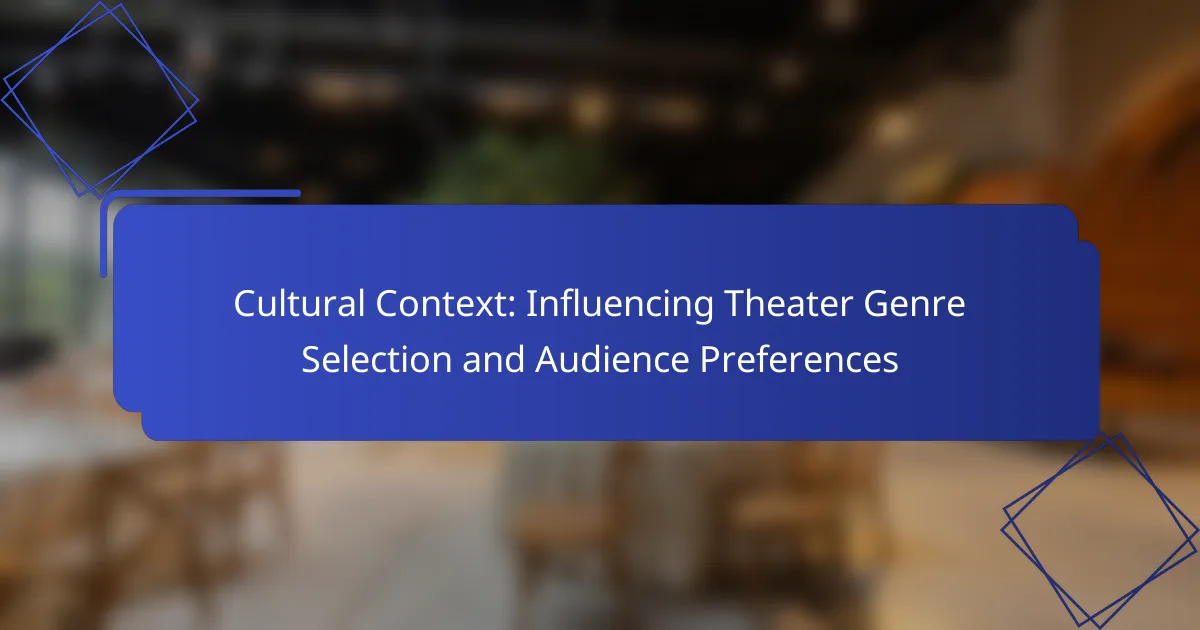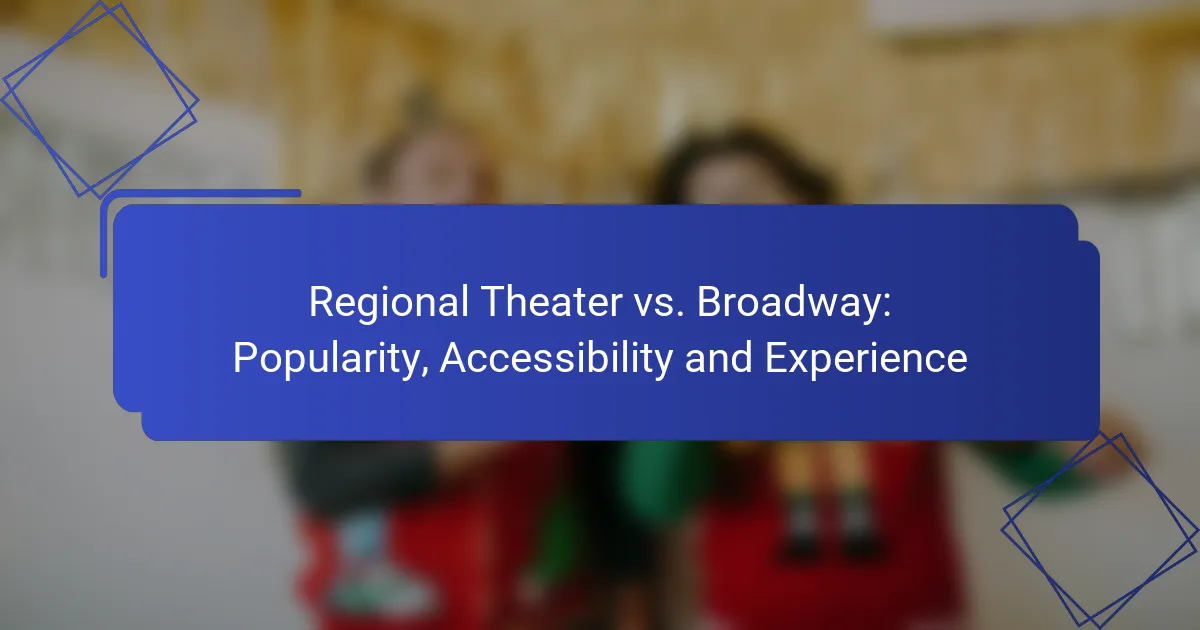Cultural context plays a crucial role in shaping theater genre selection in the United States, as it mirrors regional tastes, demographic diversity, and historical influences. Audience preferences, which are affected by cultural background, age, and societal trends, guide theater companies in curating productions that resonate with diverse viewers. By understanding these dynamics, theaters can effectively engage their audiences and reflect contemporary societal interests and values.

How does cultural context influence theater genre selection in the US?
Cultural context significantly shapes theater genre selection in the US by reflecting regional tastes, demographic diversity, and historical trends. These factors determine what types of performances resonate with audiences, influencing both production choices and attendance rates.
Regional preferences for musical theater
Musical theater enjoys widespread popularity in urban centers like New York City, where Broadway showcases a variety of productions. In contrast, smaller cities may favor community-driven performances that highlight local talent and stories, often leaning towards family-friendly musicals or adaptations of popular films.
Regional preferences can also be influenced by local culture; for instance, areas with a strong tradition of folk music may see more adaptations of musicals that incorporate these elements. Understanding these preferences can help producers tailor their offerings to better align with audience expectations.
Impact of cultural diversity on dramatic plays
The cultural diversity of the US plays a crucial role in shaping the themes and narratives of dramatic plays. Productions that reflect the experiences of various ethnic groups often attract wider audiences, as they resonate with individuals seeking representation and authenticity in storytelling.
For example, plays that explore immigrant experiences or address social justice issues can engage diverse communities, fostering a sense of connection and relevance. This cultural inclusivity not only enriches the theater landscape but also encourages dialogue among different audience segments.
Historical influences on genre popularity
Historical events and movements have profoundly influenced the popularity of theater genres in the US. The civil rights movement, for instance, led to a surge in plays that tackled themes of race and equality, while the rise of technology has given birth to innovative performances that blend traditional theater with multimedia elements.
Additionally, economic factors can shift genre popularity; during times of economic hardship, audiences may gravitate towards lighter, escapist productions. Understanding these historical influences can guide theater companies in selecting genres that resonate with current societal sentiments.

What are audience preferences in American theater?
Audience preferences in American theater vary widely, influenced by factors such as cultural background, age, and societal trends. Understanding these preferences helps theater companies tailor their productions to attract and engage diverse audiences.
Trends in audience demographics
American theater audiences have become increasingly diverse over the years, reflecting broader societal changes. Younger generations, particularly Millennials and Gen Z, tend to favor more inclusive and innovative productions that address contemporary issues.
Additionally, there is a growing interest among audiences of various ethnic backgrounds in seeing stories that resonate with their experiences. This shift encourages theaters to incorporate a wider range of voices and narratives in their programming.
Shifts in genre popularity over the decades
Over the decades, the popularity of theater genres in the U.S. has evolved significantly. While traditional genres like musicals and dramas have maintained a strong following, there has been a notable rise in interest for immersive theater and experimental performances.
In recent years, genres that blend elements of different styles, such as hip-hop theater or interactive performances, have gained traction. This trend reflects audience desires for fresh and engaging experiences that challenge conventional storytelling methods.

How do cultural events shape theater programming?
Cultural events significantly influence theater programming by guiding the selection of genres and themes that resonate with audiences. These events create a framework within which theaters can curate performances that reflect societal interests and values.
Influence of festivals on genre selection
Festivals often dictate the types of genres that theaters prioritize in their programming. For instance, a city hosting a film festival may see a rise in theatrical adaptations of popular films, while a music festival might inspire more musicals or performances that incorporate live music.
The timing of these festivals can also affect scheduling, as theaters may align their productions to coincide with these events to attract larger audiences. For example, a theater might choose to showcase a comedy during a local arts festival to capitalize on the influx of visitors.
Impact of social movements on theatrical themes
Social movements play a crucial role in shaping the themes explored in theater productions. Movements advocating for social justice, equality, or environmental issues often inspire playwrights to create works that reflect these pressing concerns, leading to a rise in plays that address topics like racial inequality or climate change.
Theaters that align their programming with contemporary social movements can enhance their relevance and connection with audiences. For example, productions that highlight [censured] rights during Pride Month can foster community engagement and support, drawing in diverse audiences eager to see their stories represented on stage.

What frameworks exist for analyzing theater genre selection?
Several frameworks help analyze theater genre selection, focusing on cultural context, audience preferences, and engagement metrics. These frameworks guide theater practitioners in understanding how to align their productions with community values and interests.
Cultural relevance criteria
Cultural relevance criteria assess how well a theater genre resonates with the values, traditions, and experiences of a specific audience. This involves considering local history, social issues, and demographic characteristics. For example, a community with a rich folklore tradition may prefer performances that incorporate local legends or narratives.
When selecting a genre, consider the cultural background of the audience. Engaging with local artists and community leaders can provide insights into what themes and stories are most meaningful. This can enhance the connection between the performance and the audience, leading to greater attendance and engagement.
Audience engagement metrics
Audience engagement metrics evaluate how effectively a theater genre captures and maintains the interest of viewers. Key metrics include ticket sales, audience feedback, and social media interactions. For instance, high ticket sales combined with positive reviews indicate a successful genre selection that resonates with the audience.
To improve audience engagement, theaters should track these metrics regularly and adapt their offerings based on feedback. Utilizing surveys and post-show discussions can provide valuable insights into audience preferences. Additionally, monitoring trends in social media can help identify emerging interests and potential new genres to explore.

How do international influences affect American theater?
International influences significantly shape American theater by introducing diverse styles, themes, and performance techniques. This cross-cultural exchange enriches the theatrical landscape, attracting varied audiences and expanding artistic expression.
Adoption of global theatrical styles
American theater increasingly incorporates global styles, such as Asian, African, and European traditions. For instance, the use of physical theater techniques from Japan or the incorporation of African storytelling methods can create unique productions that resonate with wider audiences.
Producers often blend these styles with traditional American narratives, resulting in hybrid performances that reflect a more global perspective. This fusion not only enhances creativity but also invites audiences to engage with different cultural narratives.
Collaborations with international artists
Collaborations with international artists are becoming more common in American theater, fostering a rich exchange of ideas and practices. These partnerships can lead to innovative productions that challenge conventional storytelling and performance methods.
For example, American theater companies may invite directors or playwrights from other countries to co-create works, bringing fresh viewpoints and techniques. Such collaborations can also help to build a more inclusive theater community that values diverse voices and experiences.

What emerging trends are shaping the future of theater?
Emerging trends in theater are significantly influencing genre selection and audience preferences. Key developments include the integration of technology, the rise of immersive experiences, and a heightened focus on social justice themes.
Integration of technology in performances
The integration of technology in theater is transforming how stories are told and experienced. From advanced lighting and sound design to virtual reality and projection mapping, these tools enhance the visual and auditory impact of performances.
For instance, productions are increasingly using augmented reality to create interactive elements that engage audiences more deeply. This trend not only attracts tech-savvy viewers but also allows for innovative storytelling techniques that can appeal to a broader demographic.
Rise of immersive theater experiences
Immersive theater experiences are gaining popularity, allowing audiences to become part of the narrative. This format breaks the traditional fourth wall, inviting viewers to interact with actors and explore the performance space.
Examples include site-specific productions where the audience moves through different locations, experiencing the story from various perspectives. This trend encourages a more personal connection to the material, often leading to a more memorable and impactful experience.
Focus on social justice themes
Theater is increasingly addressing social justice themes, reflecting contemporary societal issues and encouraging dialogue. Productions that tackle topics like racial inequality, gender rights, and environmental concerns resonate with audiences seeking meaningful engagement.
By incorporating these themes, theater companies can attract diverse audiences who are passionate about advocacy and change. This focus not only enriches the artistic landscape but also fosters a sense of community and shared purpose among viewers.



